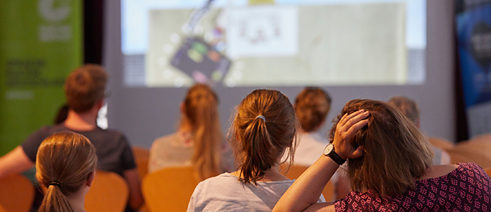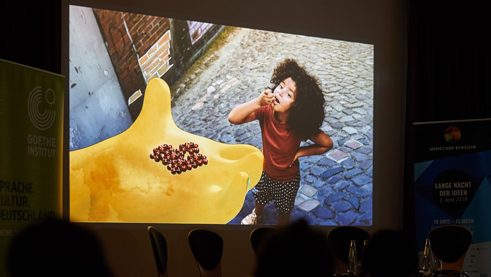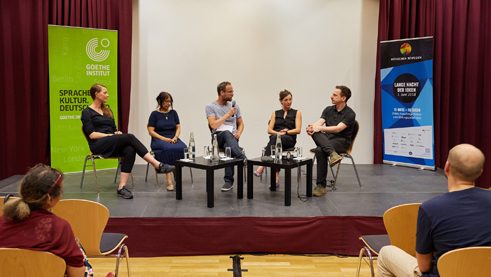2018 Long Night of Ideas
When Dancing Vegetables Encourage Kids

The episode film grenzenlos – Geschichten von Freiheit & Freundschaft (Boundless – Stories of Freedom & Friendship) celebrated its Berlin premiere as part of the Long Night of Ideas. The film, produced in cooperation with the Goethe-Institut, tells stories without language so it is understandable for children of different backgrounds. Following the screening, filmmakers discussed the medium of film in their work with refugee children and adolescents.
What do a cat, a sailboat, a yellow balloon and a magnifying glass have in common? The answer was discovered last Friday at URANIA Berlin, where the Goethe-Institut showed the episode film grenzenlos – Geschichten von Freiheit & Freundschaft as part of the Long Night of Ideas. All of these supposedly simple things help children forget their everyday woes and take them into a world full of hope, joy and opportunity. For instance, the magnifying glass in the film by Nazgol Emami, which projects green plants into an empty room or, when aimed at the dinner table by its young owner, makes jelly jiggle and cucumbers dance.
 A scene from „grenzenlos“
| Photo: Bernhard Ludewig
A scene from „grenzenlos“
| Photo: Bernhard Ludewig
Sometimes poetic, sometimes melancholic, sometimes funny
For children who have experienced traumas such as war, separation or displacement, expanding reality imaginatively can be vital. The seven stories of grenzenlos address this need; the results are sometimes poetic, sometimes melancholic, sometimes funny – and always without language. The organisers wanted to assess their results right after the Berlin premiere by asking the curious audience what they thought. A conflict mediator pointed out one essential prerequisite, saying, “If you show the film in institutions, it would be nice to pause in between stories, so that a discussion about each film can happen.” Showing them all at once poses the risk of drowning in the “soup” of impressions.Subsequently, two media educators and two filmmakers were invited to the podium to debate the question: “What can films do for children in situations of displacement and crisis?” The film scholar and director Viola Shafik debunked the idea of films being supposed “mirrors of society,” which one can overestimate or fear, as authoritarian regimes do, adding, “Whether short or long, you can’t produce a change in behaviour with one film.” Shafik, who also ensures cultural diversity in German cinemas in the selection panel of the World Cinema Fund of the Berlinale, explained, “We know from edutainment that only lots of little strokes fell the oaks.” Series, for example, would be needed for integrative purposes.
 Participants of the panel following the screening of "grenzenlos“
| Photo: Bernhard Ludewig
Participants of the panel following the screening of "grenzenlos“
| Photo: Bernhard Ludewig
The healing, integrative potential of film
Johanna Bentz, who contributed a mostly animated story to grenzenlos, responded by saying, “My aim was not to change behaviour; that would be asking too much.” The project, which was initiated three years ago, had only one objective: to produce films that make children happy and encourage them for a moment. To accomplish this without language, Bentz had remembered her own childhood days when she had make believe adventures with an older, stronger Johanna at her side.Project manager Birte Frische, who teaches cinematic crafts to young people, explains that media education can undoubtedly empower them, adding, “But that also means just letting them do it first.” This sends the signal that we have confidence in them, offering them a playground where they’re allowed to make mistakes. The filmmaker Falko Seidel also sees the healing, integrative potential of film more in the “in-between spaces” of such workshops than in the medium itself; in those moments when the group agrees on topics or divides up the work, saying, “A joint result can be created only if they pull together.” Whether the end result is a film, a play or a piece of furniture is of secondary importance.